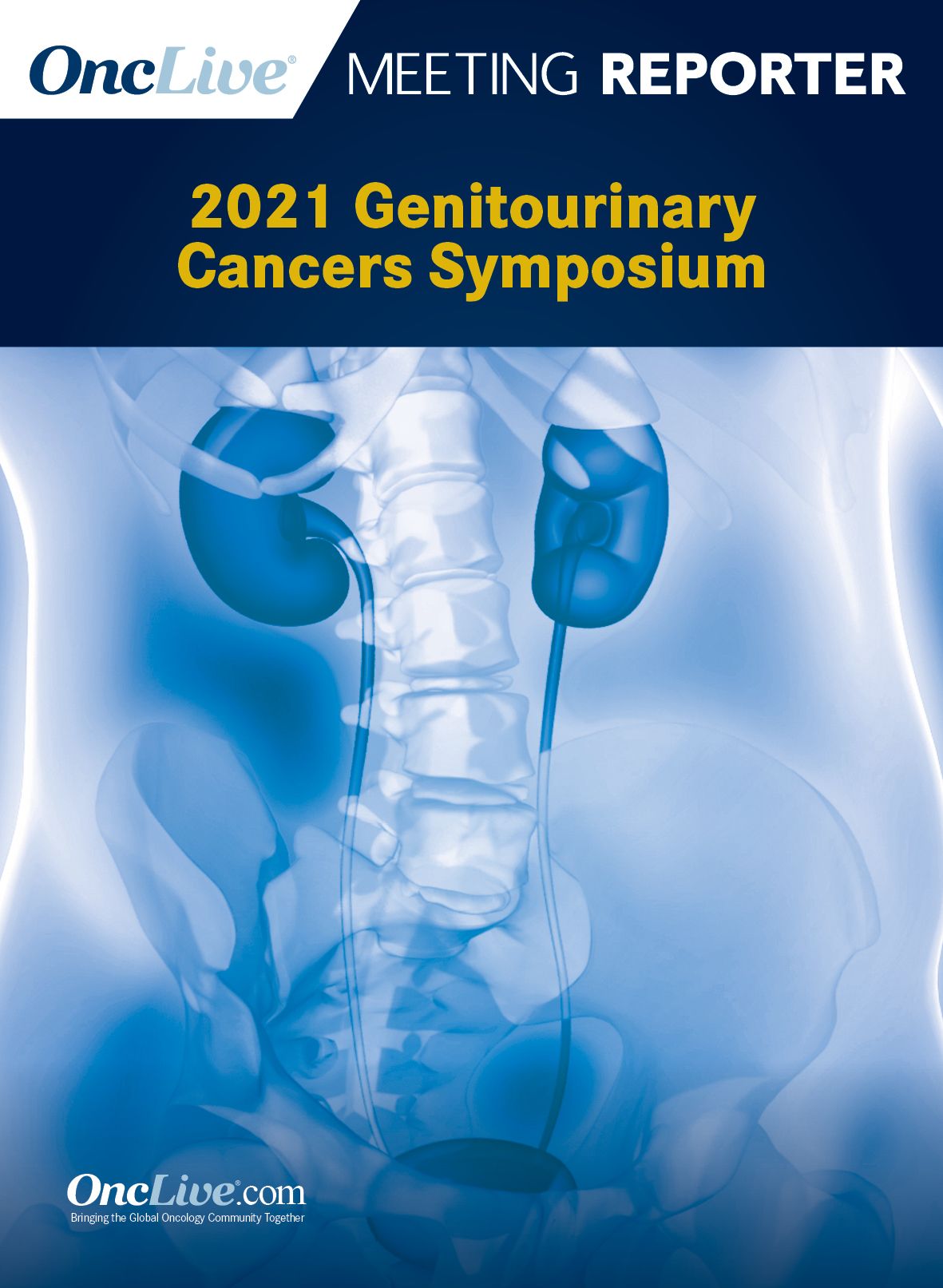Publication
Article
Supplements and Featured Publications
Frontline Nivolumab/Cabozantinib Maintains Survival Benefit Over Sunitinib in Advanced RCC
Author(s):
February 12, 2021 - The combination of nivolumab and cabozantinib continued to showcase a superior survival benefit over single-agent sunitinib when used as first-line treatment in patients with advanced renal cell carcinoma.
Robert J. Motzer, MD

The combination of nivolumab (Opdivo) and cabozantinib (Cabometyx) continued to showcase a superior survival benefit over single-agent sunitinib (Sutent) when used as first-line treatment in patients with advanced renal cell carcinoma, according to extended follow-up data from the phase 3 CheckMate-9ER trial (NCT03141177) presented during the 2021 Genitourinary Cancers Symposium.1
After a minimum follow-up of 16 months, the combination showed an approximate doubling of both progression-free survival (PFS) and overall survival (OS) compared with sunitinib in data presented in a poster presentation during the 2021 Genitourinary Cancer Symposium; these results were consistent with earlier reports from the trial, leading to the FDA approval of the regimen.
“The superior efficacy of nivolumab plus cabozantinib over sunitinib was maintained with extended 16-month minimum follow-up,” Robert J. Motzer, MD, head of the Kidney Cancer Section, and Jack and Dorothy Byrne Chair in Clinical Oncology, Memorial Sloan Kettering Cancer Center, said in a presentation of the poster. “These results continue to support nivolumab plus cabozantinib as a potential new first-line treatment option for patients with advanced RCC.”
Additionally, an exploratory subgroup analysis from the study suggested that survival and response benefits with the combination regimen was seen regardless of sarcomatoid histology.
Earlier findings from the study were presented at the 2020 ESMO Virtual Congress with a minimum follow-up of 10.6 months,2 showing a median PFS of 16.6 months with nivolumab and cabozantinib versus 8.3 months with sunitinib (HR, 0.51; 95% CI, 0.41-0.64). OS data were not yet reached in either arm of the study as of the data cutoff. The objective response rate (ORR) at this time was 55.7% with nivolumab and cabozantinib versus 27.1% with sunitinib.
In January 2021, the FDA granted approval to the nivolumab/cabozantinib doublet as treatment of patients with advanced RCC in the frontline setting based on these data.3
Extended follow-up with a data cutoff of September 10, 2020 amounted to a median of 23.5 months (range, 16.0-36.0). As of this cutoff, the median PFS by blinded independent central review (BICR) in the intention-to-treat population was 17.0 months (95% CI, 12.6-19.4) in the nivolumab and cabozantinib arm compared with 8.3 months (95% CI, 6.9-9.7) in the sunitinib arm (HR, 0.52; 95% CI, 0.43-0.64; P <.0001). The median OS still was not reached in the nivolumab/cabozantinib arm but was 29.5 months (95% CI, 28.4-not evaluable) in the sunitinib arm (HR, 0.66; 95% CI, 0.50-0.87; P = .0034).
The ORR continued to be significantly greater in the nivolumab/cabozantinib arm versus the sunitinib arm at 54.8% (95% CI, 49.2%-60.3%) versus 28.4% (95% CI, 23.5%-33.6%), respectively (odds ratio estimate, 3.2; 95% CI, 2.3-4.4). Complete response as best overall response was observed in 30 patients (9.3%) in the doublet arm versus 14 (4.3%) in the sunitinib monotherapy arm. Stable disease was also achieved by 33.4% in the combination arm and 41.5% in the single-agent arm.
The median time to response (TTR) was shorter in the nivolumab/cabozantinib arm at 2.8 versus 4.2 months and the median duration of response (DOR) was longer with the combination at 21.7 versus 12.7 months. At 18 months, the probability of ongoing response was 56% (95% CI, 46%-64%) with nivolumab and cabozantinib compared with 43% (95% CI, 30%-55%) with sunitinib.
Forty-five percent of patients in the nivolumab and cabozantinib arm and 22.2% in the sunitinib arm remained on therapy as of the extended data cutoff date. The primary reason for treatment discontinuation was disease progression in both arms (33.4% vs 52.8% with sunitinib).
Among patients who discontinued treatment, 31.8% who received nivolumab/cabozantinib received subsequent systemic treatment, most commonly a VEGF targeted therapy (25.0%), and 45.0% of those who had received sunitinib and discontinued went on to receive subsequent therapy, which most commonly included nivolumab (29.7%).
The adverse event (AE) profile for the combination regimen was consistent with prior reports for each of the agents individually and no new safety signals were observed. AEs of any cause were reported in 99.7% of patients in the nivolumab/cabozantinib arm and 99.1% of the sunitinib arm of the safety-evaluable patients (n = 640), events were grade 3 or higher in severity in 78.4% and 73.1%, respectively.
Treatment-related AEs (TRAEs) were reported in 96.9% and 93.1% of the combination and monotherapy arms, respectively, and TRAEs were grade 3 or higher in 62.2% and 52.5%, respectively. The most common TRAEs with the combination were diarrhea (58.4%), hand-foot syndrome (38.1%), hypothyroidism (35.0%), hypertension (31.3%), fatigue (26.9%), alanine aminotransferase (ALT) increase (26.9%), and aspartate aminotransferase (AST) increase (25.3%). Grade 3 or higher hypertension was reported in 11.6%, hand-foot syndrome in 7.5%, diarrhea in 6.6%, ALT increase in 5.0%, and AST increase in 3.4%. ALT and AST increase was reported more frequently in the combination arm compared with the sunitinib monotherapy arm.
TRAEs led to treatment discontinuation of nivolumab in 9.7% of patients, of cabozantinib in 7.2%, of both nivolumab and cabozantinib in 6.6%, and of sunitinib in 9.1%.
Corticosteroids were needed in 20.9% of patients in the immunotherapy/tyrosine kinase inhibitor combination arm to manage immune-mediated AEs.
One death in the combination arm was reported due to a TRAE and 2 deaths in the sunitinib arm due to TRAEs, as previously reported in the primary analysis.
Sarcomatoid Subgroup
A total of 75 patients (34 in the combination arm, 41 in the monotherapy arm) had sarcomatoid histology in the study. Amongst this subgroup, the median age was 59 years (range, 36-76) in the nivolumab/cabozantinib arm and 60 years (range, 40-80) in the sunitinib arm. The majority of patients with sarcomatoid features in each arm were male (69.3%), had intermediate International Metastatic RCC Database Consortium (IMDC) prognostic scores (65.3%), and had at least 2 lesion sites (80%). Additionally, in the nivolumab/cabozantinib arm, 44.1% of these patients had positive (≥1%) PD-L1 expression and 55.9% had negative or indeterminate expression levels, whereas half had positive expression and half had negative or indeterminate expression in the sunitinib arm.
Among patients with sarcomatoid feature, the median PFS was 10.3 months (95% CI, 5.6-19.4) in the combination arm versus 4.2 months (95% CI, 2.6-8.3) in the sunitinib monotherapy arm (HR, 0.42; 95% CI, 0.23-0.74). Patients who did not have sarcomatoid histology, on the other hand, had a median PFS of 17.5 months (95% CI, 13.1-20.0) and 9.2 months (95% CI, 7.1-9.8) in the doublet and single-agent arms, respectively (HR, 0.56; 95% CI, 0.45-0.69).
In terms of OS, the median was not reached in patients with or without sarcomatoid features who were treated with nivolumab/cabozantinib, nor was it reached for patients without sarcomatoid histology who were treated with sunitinib. The hazard ratio for OS in the sarcomatoid-positive group was 0.36 (95% CI, 0.17-0.79) and 0.73 (95% CI, 0.54-0.98) in the sarcomatoid-negative group.
“Notable efficacy benefits were observed with nivolumab plus cabozantinib versus sunitinib regardless of sarcomatoid status,” Motzer said.
The ORR was higher in the nivolumab/cabozantinib arm regardless of sarcomatoid histology with an ORR of 55.9% (95% CI, 37.9%-72.8%) in the positive patients and 54.7% (95% CI, 48.7%-60.5%) in the negative patients. Comparatively, in the sunitinib arm, patients with sarcomatoid features had an ORR of 22.0% (95% CI, 10.6-37.6%) and 29.3% (95% CI, 24.1%-34.9%) among patients without sarcomatoid features. Similarly, median TTR was shorter in in the nivolumab/cabozantinib arm regardless of sarcomatoid histology and the median DOR was greater in the doublet arm.
Ninety-four percent of patients with sarcomatoid features in the nivolumab/cabozantinib arm experienced a reduction in their target lesion size compared with 72% in the sunitinib arm.
No new safety signals were observed in the sarcomatoid subgroups either.
References
- Motzer RJ, Choueiri TK, Powles T, et al. Nivolumab + cabozantinib (NIVO+CABO) versus sunitinib (SUN) for advanced renal cell carcinoma (aRCC): Outcomes by sarcomatoid histology and updated trial results with extended follow-up of CheckMate 9ER. J Clin Oncol. 2021;39(suppl 6):308. doi:10.1200/JCO.2021.39.6_suppl.308
- Choueiri TK, Powles T, Burotto M, et al. 696O_PR Nivolumab + cabozantinib vs sunitinib in first-line treatment for advanced renal cell carcinoma: first results from the randomized phase 3 CheckMate 9ER trial. Ann Oncol. 2020;31(suppl 4).S1159. doi:10.1016/j.annonc.2020.08.2257
- FDA approves nivolumab plus cabozantinib for advanced renal cell carcinoma. News release. FDA. January 22, 2021. Accessed February 12, 2021. https://bit.ly/3iEIlMj










